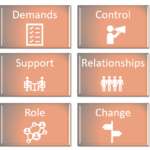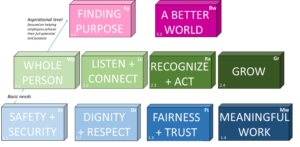Our modern value systems cause stress, anxiety, burnout, and weaken our resilience overall. In a world largely driven by capitalism, efficiency and the pursuit of profit, humans are often seen as nothing more than a factor of production or a cog in a machine.
The estimated 4 billion employees on the planet are not doing that great and it is not going to get better, according to a report by the Global Wellness Institute. Indeed, employees:
- Face economic insecurity never felt or experienced before
- Are on average older and less in good health
- Are stressed and depressed
And it costs money, lots of money to the global economy. In the United States alone, corporate ill-being is estimated to cost some $ 2.2 trillion in annual loss, which represents 12% of the country’s GDP. While globally, the cost of unwell workers represents 10-15% of global economic output.
Research shows that it is not corporate wellbeing programs that improve employee health and productivity, but rather how they perceive them. Employees should perceive their employer to be genuinely “caring” and willing to take care of the health and well-being of their troops. In fact, according to the Global Wellness Institute, the figures speak for themselves. When organizations take care of their employees, health and stress levels improve significantly:
| Employees: | Caring companies | Non-caring companies |
| rate their health/wellness high | 57% | 39% |
| report poor personal health | 8% | 21% |
| report “very high” stress | 17% | 41% |
| are dramatically more engaged | 52% | 25% |
| are proud to be associated with the company | 68% | 19% |
But what is the definition of an organisation that “takes care”, what is a “caring organisation”?
Research by the Global Wellness Institute shows that the elements that characterise a caring organisation are far more intangible than tangible. The flexibility of the working hours, an open and honest culture, where the management leads by example by walking the talk, or the autonomy of when and how I do my job, are all much more important elements than the remuneration, the benefits, or the working environment.
It’s interesting how such results match the Health Safety and Environment (HSE) Management Standard developed in the UK several years ago. These management standards cover six key areas of work design described below which, if not properly managed, are associated with poor health, decreased productivity, and increased absence rates due to illness or accident.

In these standards, we can see the importance of autonomy, of the organisation and managers’ support, as well as the importance of leadership behaviour, the famous “walk the talk”. If you are interested in the topic, we discuss these Management Standards in more detail in this article on Resilience and Anxiety.
It is important to help employees feel good, both for individuals and for the success of the organisation. However, the idea of “caring” is not natural in an organisational setting. In fact, in 2020, 92% of employees said organisations should do more to address the overall workers’ wellbeing and needs.
Focusing on efficiency, return on investment, and performance comes a lot more naturally to leaders than focusing on “caring” behaviour.
Considering the demands of today’s workforce and the benefits of a caring culture, how can employers change the paradigm and build a caring culture.
A caring culture, key to performance
More recent research continues to support the importance of having a caring approach and culture towards employees. For example, Businessolver shows in its 2020 State of Workplace Empathy report a strong relationship between empathy (the ability to understand and experience another’s feelings) and employee engagement and performance. More specifically, they found that 80% of employees surveyed would quit their current jobs for a more caring and compassionate employer, and 74% would agree to work longer hours for an empathetic employer.
Organisational literature indicates that there are several factors that positively influence employee perceptions that their organisations care about them.
The Limeade Institute, whose mission is to conduct research, establish market perspectives and monitor employees’ wellbeing and engagement around the world, has developed a framework for caring organisations.
The framework consists of three levels starting from a level that brings together basic needs (in blue below) to an ambitious level (in pink below) focused on how to help employees find their purpose in life. While this is not an exhaustive list, these “caring” elements provide a framework to further define organisational needs and to offer guidance on how organisations can begin to create a caring experience for employees.

Source: Limeade Care Elements (2019)
2nd level (green)
- Whole person: EAP, flexible working hours, Inclusion and Diversity, etc.
- Listen + Connect: through formal and informal meetings, through scientific surveys, communicate with transparency to build trust
- Recognise + Act: recognise early signs and symptoms and act accordingly
- Grow: help employees to develop and grow
3rd level (pink)
- Finding purpose: not only at work but in employee’s life, give a clear vision of organisation’s purpose to help employees how to best fit in
- A better world: support causes that affect employees, encourage volunteering, align social responsibility goals with those of employees
Organisations need to go further than just encouraging dialogue and best practices around wellbeing. Now is the time to integrate the topic into every aspect of the organisation: culture, values, mission. It is up to the employers to also integrate wellbeing into the design and execution of work, and to fundamentally rethink work with positive wellbeing outcomes in mind, rather than simple wellness activities put together.
The Readiness Gap
Wellbeing had the largest gap between importance and readiness across 2020’s trends. According to Deloitte’s 2020 Global Human Capital Trends report, 80% of organizations saying employee wellbeing is important or very important for their success, but only 12% saying they are very ready to address the issue. Knowing that the tipping point is around 15%, perhaps we can remain optimistic about the direction that corporate health and well-being will take.
Investing in wellbeing is for good reason. 95% of HR managers agree that burnout has an impact on employee retention, and a study by Limeade and Quantum Workplace found that employees with higher wellbeing level are more likely to feel engaged at work, love their job and recommend their employer.
Unlike previous editions of Global Human Capital Trends, 2020 saw two new trends that did rise to the top with almost identical scores: wellbeing and belonging. Organisations need to foster belonging at three levels. And we will see how we can take a similar approach with wellbeing:
1) Comfort, where employees feel respected and treated fairly
2) Connection, where employees have strong bonds with their colleagues and teams
3) Contribution, where employees understand how their unique strengths are helping their teams and organisations achieve common goals
While comfort has been activated with an emphasis on occupational health and safety, and the connection has been made by bringing personal life to work, the contribution itself remains largely unresolved.
Indeed, wellbeing programs often focus on the employee at work rather than the individual in work. To be able to create a sense of contribution that translates into true organisational performance, organisations need to expand their focus from health programmes adjacent to work to designing wellbeing into the work itself.
Redesigning work around wellbeing can yield impressive results. One of the examples to illustrate this is Microsoft Japan which experimented during the summer of 2019 a new way of working: reducing the working week from 5 to 4 days for everyone. In addition to this reduction (for the same salary), Microsoft Japan changed certain aspects: employees were asked to use a digital chat tool rather than email and to limit meetings to just 30 minutes and five people maximum. What’s interesting is that during the duration of the experiment, the company reported a 40% increase in productivity and a 23% reduction in electricity costs.
Along the same line, one of the themes of the 2021 agenda of the World Economic Forum is, you will never guess, employees’ wellbeing as a priority for companies. To truly build a more resilient workforce and rebuild the economy in 2021 and beyond, employers should prioritise wellbeing and health. Companies need to see wellbeing as a tangible skill, an essential business contribution, and with a measurable result. Still according to the WEF, it is essential that leaders value the wellbeing of their teams and peers as well as their technical skills. By putting wellbeing at the forefront, and supporting it through actions, leaders will be able to switch from a culture where work comes before personal needs, to a caring culture.
Indeed, it seems that the perception that wellbeing and productivity are not compatible may be completely wrong. It is up to us all to foster a sense of belonging and contribution, while cultivating care and kindness within organisations.
“We are not all in the same boat. We are all in the same storm. Some are on super-yachts. Some have just the one oar.”
Damien Barr, British writer


